Gravitational Force: Difference between revisions
(→Units) |
|||
| (30 intermediate revisions by 2 users not shown) | |||
| Line 1: | Line 1: | ||
'''CLAIMED BY BRIAN DUFFY''' | '''CLAIMED BY BRIAN DUFFY''' | ||
This topic covers Newton's Law of Universal Gravitation. | This topic covers Newton's Law of Universal Gravitation. | ||
| Line 5: | Line 6: | ||
[[File:Newtonlawofgravitation.jpg|250px|thumb|right|Newton's Law of Universal Gravitation]] | [[File:Newtonlawofgravitation.jpg|250px|thumb|right|Newton's Law of Universal Gravitation]] | ||
==Main Idea== | ==Main Idea== | ||
Gravitational Force, defined in Newton's law of Universal Gravitation is the attractive force between any two bodies of any mass, at any distance. Gravity is one of the essential forces that hold the Universe together. | Gravitational Force, defined in Newton's law of Universal Gravitation, is the attractive force between any two bodies of any mass, at any distance. Gravity is one of the essential forces that hold the Universe together. Newton's law of universal gravitation states that every object with mass in the universe is attracting every other object with mass with a force that is directly proportional to the product of their masses and inversely proportional to the square of the distance between them. Gravitational Force is considered to be the weakest of the four fundamental forces of nature (strong nuclear force, electromagnetic force, weak nuclear force and gravity). The first test of this law was performed in the laboratory by the British scientist Henry Cavendish in 1798, 72 years after the death of Sir Isaac Newton. This test defined the gravitational constant ''G''. | ||
===A Mathematical Model=== | ===A Mathematical Model=== | ||
The gravitational law states that every mass attracts | The gravitational law states that every mass attracts every other mass by a force acting on the line intersecting both points. The force is directly proportional to the product of the masses and inversely proportional to the square of the distance between them. The two masses involved are considered point masses, and thus any density variations or irregular shaping can be ignored. | ||
[[File:1232.png|200px|thumb|right|Two masses at a certain distance attracting each other]] | [[File:1232.png|200px|thumb|right|Two masses at a certain distance attracting each other]] | ||
::<math>|\vec{\mathbf{F}}_{grav}|= G \frac{m_1 m_2}{r^2}\ </math> | ::<math>|\vec{\mathbf{F}}_{grav}|= G \frac{m_1 m_2}{r^2}\ </math> | ||
| Line 26: | Line 28: | ||
[[File:Relative_position.png|200px|thumb|right|Distance between two objects, object 2 and object 1 used to calculate the relative position:"final minus initial" and its direction]] | [[File:Relative_position.png|200px|thumb|right|Distance between two objects, object 2 and object 1 used to calculate the relative position:"final minus initial" and its direction]] | ||
The relative position vector <math>\vec{\mathbf{r}}</math> is the distance from the center of object 1 to the center of object 2. The relative position between these two | The relative position vector <math>\vec{\mathbf{r}}</math> is the distance from the center of object 1 to the center of object 2. The relative position between these two objects can be represented as <math>\vec{\mathbf{r}}_{2-1}</math>, which means that it is the difference between the position of object 1 and the position of object 2. The magnitude of <math>\vec{\mathbf{r}}</math>, represented as <math>r</math> or <math>|\vec{\mathbf{r}}|</math>, is the distance between the center of two objects, found by taking the square root of the squares of each vector component, as shown below: | ||
::<math>r=|\vec{\mathbf{r}}|=\sqrt{r_x^2+r_y^2+r_z^2}</math> | |||
::r sub x, y, and z represent respectively the x, y, and z distances to the point in question. | |||
The direction of the gravitational force on object 2 by object 1 is specified by a unit vector,<math>-\mathbf{\hat{r}}</math>, with a minus sign in front of it. The minus sign shows that the force on object 2 by 1 is in the opposite direction to <math>\mathbf{\hat{r}}</math>. | The direction of the gravitational force on object 2 by object 1 is specified by a unit vector,<math>-\mathbf{\hat{r}}</math>, with a minus sign in front of it. The minus sign shows that the force on object 2 by 1 is in the opposite direction to <math>\mathbf{\hat{r}}</math>. Because the gravitational force is an attractive force between two bodies, the magnitude of the gravitational force on one object in the duo is the same as the magnitude of the gravitational force on the other object, but in the opposite direction. | ||
[[File:Gravitational_field.png|200px|thumb|right|Gravitational Field around the Earth. Near the surface of the Earth an object m experience a force of mg. The g of the field decreases with increase in distance from the Earth]] | [[File:Gravitational_field.png|200px|thumb|right|Gravitational Field around the Earth. Near the surface of the Earth an object m experience a force of mg. The g of the field decreases with increase in distance from the Earth]] | ||
Steps for calculating Gravitational Force | Steps for calculating Gravitational Force | ||
| Line 36: | Line 40: | ||
::* Calculate the unit vector <math>-\mathbf{\hat{r}}</math> =<math>\vec{\mathbf{r}}</math> /<math>|\vec{\mathbf{r}}|</math> | ::* Calculate the unit vector <math>-\mathbf{\hat{r}}</math> =<math>\vec{\mathbf{r}}</math> /<math>|\vec{\mathbf{r}}|</math> | ||
::* Multiply the Magnitude, <math>|\vec{\mathbf{F}}_{grav}|</math>, by the unit vector. | ::* Multiply the Magnitude, <math>|\vec{\mathbf{F}}_{grav}|</math>, by the unit vector. | ||
===A Computational Model=== | ===A Computational Model=== | ||
| Line 77: | Line 72: | ||
vcraft = pcraft / mcraft | vcraft = pcraft / mcraft | ||
craft.pos = craft.pos + (vcraft*deltat) | craft.pos = craft.pos + (vcraft*deltat) | ||
==Examples== | ==Examples== | ||
| Line 92: | Line 84: | ||
::<math> |\mathbf{F_{g}}| = G \frac{m_E m_M}{r^2} </math> | ::<math> |\mathbf{F_{g}}| = G \frac{m_E m_M}{r^2} </math> | ||
::<math> |\mathbf{F_{g}}| = 6.7x10^{-11} \frac{6e24 * 70}{6.38 x 10^6} </math> | ::<math> |\mathbf{F_{g}}| = 6.7x10^{-11} \frac{6e24 * 70}{(6.38 x 10^6)^2} </math> | ||
::<math> |\mathbf{F_{g}}| =686 N </math> | ::<math> |\mathbf{F_{g}}| =686 N </math> | ||
| Line 99: | Line 91: | ||
The solution of the problem involves substituting known values of G (<math>6.673 x 10^{-11}</math>N m<sup>2</sup>/kg<sup>2</sup>), m<sub>1</sub> <math>6 x 10^ {24}</math> kg, m<sub>2</sub> <math>7 x 10^ {22}</math> kg and d <math><2.8 x 10^8,0,-2.8 x 10^8></math> m m into the universal gravitation equation and solving for F<sub>grav</sub>. The solution is as follows: | The solution of the problem involves substituting known values of G (<math>6.673 x 10^{-11}</math>N m<sup>2</sup>/kg<sup>2</sup>), m<sub>1</sub> <math>6 x 10^ {24}</math> kg, m<sub>2</sub> <math>7 x 10^ {22}</math> kg and d <math><2.8 x 10^8,0,-2.8 x 10^8></math> m m into the universal gravitation equation and solving for F<sub>grav</sub>. The solution is as follows: | ||
[[File: | [[File:Force_earth_moon.png|400px|thumb|right|Gravitational Force Between Moon and Earth]] | ||
: '''(a)''' The position vector of Moon relative to Earth is, | : '''(a)''' The position vector of Moon relative to Earth is, | ||
| Line 123: | Line 115: | ||
::<math> \vec{\mathbf{F}}_{g}</math> = <math><-1.232x10^{20},0,1.232x10^{20}> N </math> | ::<math> \vec{\mathbf{F}}_{g}</math> = <math><-1.232x10^{20},0,1.232x10^{20}> N </math> | ||
===Difficult=== | === Difficult === | ||
''In the following problems you will be asked to calculate the net gravitational force acting on the Moon.To do so, please use the following variables:'' | ''In the following problems you will be asked to calculate the net gravitational force acting on the Moon.To do so, please use the following variables:'' | ||
| Line 143: | Line 136: | ||
::<math>\vec{\mathbf{r}} = \vec{\mathbf{r_M}}-\vec{\mathbf{r_E}}</math> | ::<math>\vec{\mathbf{r}} = \vec{\mathbf{r_M}}-\vec{\mathbf{r_E}}</math> | ||
::<math>\vec{\mathbf{r}}</math> = <<math>L,h,0></math>-<<math>L,0,0></math> | ::<math>\vec{\mathbf{r}}</math> = <<math>L,h,0></math>-<<math>L,0,0></math> | ||
::<math>\vec{\mathbf{r}}</math> = <<math>0,h,0> | ::<math>\vec{\mathbf{r}}</math> = <<math>0,h,0> </math> | ||
:: <math>|\vec{\mathbf{r}}| = \sqrt{(0^2+h^2+0^2)}</math> | :: <math>|\vec{\mathbf{r}}| = \sqrt{(0^2+h^2+0^2)}</math> | ||
:: <math>|\vec{\mathbf{r}}| = h </math> | :: <math>|\vec{\mathbf{r}}| = h </math> | ||
::<math>\mathbf{\hat{r}} = \frac {\vec{\mathbf{r}}}{|\vec{\mathbf{r}}|}</math> | ::<math>\mathbf{\hat{r}} = \frac {\vec{\mathbf{r}}}{|\vec{\mathbf{r}}|}</math> | ||
| Line 155: | Line 148: | ||
::<math> |\vec{\mathbf{F}}_{g_1}| = G \frac{m_E m_M}{h^2} </math> | ::<math> |\vec{\mathbf{F}}_{g_1}| = G \frac{m_E m_M}{h^2} </math> | ||
::<math> \vec{\mathbf{F}}_{g_1} = -|\vec{\mathbf{F}}_{g_1}|*{mathbf{\hat{r}}}</math> | ::<math> \vec{\mathbf{F}}_{g_1} = -|\vec{\mathbf{F}}_{g_1}|*{\mathbf{\hat{r}}}</math> | ||
::<math> \vec{\mathbf{F}}_{g_1} = <0,-G \frac{m_E m_M}{h^2},0> N </math> | ::<math> \vec{\mathbf{F}}_{g_1} = <0,-G \frac{m_E m_M}{h^2},0> N </math> | ||
| Line 182: | Line 175: | ||
==Connectedness== | ==Connectedness== | ||
:* The | :* Nothing interests and intrigues me as much as outer space, and the first step to understanding that is to understand the Law of Universal Gravitation. The only reason we are alive today, and part of the solar system we are in is because of the force of gravity. It controls the tides of the oceans, the orbit of Earth, and the distance of planets to the Sun (which are vital for the survival of life). It is one of the most basic concepts you learn in physics, but one of the most important of the natural forces that work to keep our universe in balance. | ||
:* | :* As a Mechanical Engineering major, gravitational force could be important if I ever work in the aerospace field, where you must determine how much lift an airplane or spaceship needs to get off the ground in order to counteract the force of gravity. Also, if I ever assist in the designing of buildings, it is important to know all of the forces that act on them, including gravity. | ||
:* Newton's Law of Universal Gravitation | :* Newton's Law of Universal Gravitation acts on every single object that you see around you every day. Without it, football games would be no fun because the ball would never come back to the ground, and also because all the players and spectators would be floating off into space. If a planet or object in space has a different orbit than expected, then it can be used to find new bodies that cause that change in orbit. If we did not know the force of gravity, we would not know how fast rockets need to travel to exit the atmosphere, and how high satellites must float in order to stay in the orbit the Earth. The Apollo 13 crew would never have been able to make it back to their families had Houston not known the exact gravitational forces that the moon could exert on the spacecraft. | ||
==History== | == History == | ||
[[File:SirIsaacNewton.jpg |150px|thumb|right|Portrait of Isaac Newton]] | [[File:SirIsaacNewton.jpg |150px|thumb|right|Portrait of Isaac Newton]] | ||
Sir Isaac Newton, the 17<sup>th</sup> century English scientist | Sir Isaac Newton, the 17<sup>th</sup> century English scientist is considered one of the most important minds of the Scientific Revolution. He is popularly associated with discovering the force of gravity but scientists had been studying gravity for centuries before Newton. Based on Galileo’s and Kepler’s works on heliocentric solar system, Newton published “Principia” in 1687, in which he explained that the force that causes the planets to orbit the Sun is the same force that makes objects fall to and remain on the surface of the Earth. Newton explained that gravity is a force that attracts different masses and is inversely proportional to the square distance between the objects. However Newton did not fully understand how gravitational force acted from one object to another over vast distances due to the limited tools at his disposal. Despite this flaw, the law he developed has been used for more than three centuries and is still used mostly without issue to approximate the motion of bodies acting under gravitational force. Albert Einstein rejected it in his explanation of the Theory of Relativity, saying that the gravitational force is a result of the curvature of space-time. This theory explains a number of phenomena we observe around extremely massive bodies, including the curving of light around such bodies. | ||
While Newton's theory of gravity falls apart under scrutiny near extremely massive bodies, and cannot explain some of the phenomena we see around these bodies, it is a good enough approximation for most situations that are encountered. | |||
== See also == | == See also == | ||
:* For an interesting lab on the Law of Universal Gravitation visit [https://phet.colorado.edu/en/simulation/gravity-force-lab here] | |||
:* For more information and applications pertaining to the gravitational force visit [http://hyperphysics.phy-astr.gsu.edu/hbase/grav.html here] | |||
:* This video here is much like the experiment done in lecture, and attempts to show how gravity acts on small objects by using a conical shape [https://www.youtube.com/watch?v=MTY1Kje0yLg Watch]. | |||
:* [https://www.youtube.com/watch?v=p_o4aY7xkXg Here] is a short video that reinforces the concepts laid out above. | |||
===Further reading=== | ===Further reading=== | ||
Latest revision as of 15:28, 14 June 2019
CLAIMED BY BRIAN DUFFY
This topic covers Newton's Law of Universal Gravitation.
Created by Ankit Khanal.

Main Idea
Gravitational Force, defined in Newton's law of Universal Gravitation, is the attractive force between any two bodies of any mass, at any distance. Gravity is one of the essential forces that hold the Universe together. Newton's law of universal gravitation states that every object with mass in the universe is attracting every other object with mass with a force that is directly proportional to the product of their masses and inversely proportional to the square of the distance between them. Gravitational Force is considered to be the weakest of the four fundamental forces of nature (strong nuclear force, electromagnetic force, weak nuclear force and gravity). The first test of this law was performed in the laboratory by the British scientist Henry Cavendish in 1798, 72 years after the death of Sir Isaac Newton. This test defined the gravitational constant G.
A Mathematical Model
The gravitational law states that every mass attracts every other mass by a force acting on the line intersecting both points. The force is directly proportional to the product of the masses and inversely proportional to the square of the distance between them. The two masses involved are considered point masses, and thus any density variations or irregular shaping can be ignored.
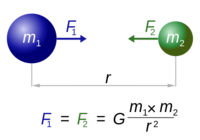
- [math]\displaystyle{ |\vec{\mathbf{F}}_{grav}|= G \frac{m_1 m_2}{r^2}\ }[/math]
- where,
- F is the gravitational force between the masses;
- G is the gravitational constant [math]\displaystyle{ 6.674×10^{−11} \frac{N m^2}{kg^2}\ }[/math];
- m1 is the mass of the first object;
- m2 is the mass of the second object;
- r is the distance between the centers of both masses.
Vector Form
Newton's law of universal gravitation can be expressed in vector form to account for the direction of the gravitational force.
- [math]\displaystyle{ \vec{\mathbf{F}}_{grav}= -G \frac{m_1 m_2}{r^2}\ }[/math][math]\displaystyle{ \mathbf{\hat{r}} }[/math]
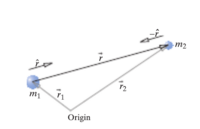
The relative position vector [math]\displaystyle{ \vec{\mathbf{r}} }[/math] is the distance from the center of object 1 to the center of object 2. The relative position between these two objects can be represented as [math]\displaystyle{ \vec{\mathbf{r}}_{2-1} }[/math], which means that it is the difference between the position of object 1 and the position of object 2. The magnitude of [math]\displaystyle{ \vec{\mathbf{r}} }[/math], represented as [math]\displaystyle{ r }[/math] or [math]\displaystyle{ |\vec{\mathbf{r}}| }[/math], is the distance between the center of two objects, found by taking the square root of the squares of each vector component, as shown below:
- [math]\displaystyle{ r=|\vec{\mathbf{r}}|=\sqrt{r_x^2+r_y^2+r_z^2} }[/math]
- r sub x, y, and z represent respectively the x, y, and z distances to the point in question.
The direction of the gravitational force on object 2 by object 1 is specified by a unit vector,[math]\displaystyle{ -\mathbf{\hat{r}} }[/math], with a minus sign in front of it. The minus sign shows that the force on object 2 by 1 is in the opposite direction to [math]\displaystyle{ \mathbf{\hat{r}} }[/math]. Because the gravitational force is an attractive force between two bodies, the magnitude of the gravitational force on one object in the duo is the same as the magnitude of the gravitational force on the other object, but in the opposite direction.
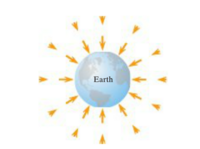
Steps for calculating Gravitational Force
- Calculate [math]\displaystyle{ \vec{\mathbf{r}} }[/math] by using the position of the center of object 2 relative to the center of object 1, keeping this in vector notation. i.e. [math]\displaystyle{ \vec{\mathbf{r}} = \vec{\mathbf{r}}_2-\vec{\mathbf{r}}_1 }[/math]
- Calculate center to center distance between the objects, by finding the magnitude of the vector above [math]\displaystyle{ |\vec{\mathbf{r}}| }[/math]
- Calculate [math]\displaystyle{ |\vec{\mathbf{F}}_{grav}| }[/math] using the equation for gravitational force
- Calculate the unit vector [math]\displaystyle{ -\mathbf{\hat{r}} }[/math] =[math]\displaystyle{ \vec{\mathbf{r}} }[/math] /[math]\displaystyle{ |\vec{\mathbf{r}}| }[/math]
- Multiply the Magnitude, [math]\displaystyle{ |\vec{\mathbf{F}}_{grav}| }[/math], by the unit vector.
A Computational Model
A computational representation of Gravitational force can be created using VPython.
The code below show how we can find the net force, momentum and final position in Python.
while t < 235920:
rate(5000)
#Calculate the Gravitational Force acting on the craft due to Earth and Moon
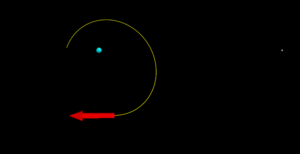
#Craft to Earth Calculations
r = craft.pos - Earth.pos
rmag = sqrt(r.x**2 + r.y**2 + r.z**2)
rhat = r / rmag
fgravmag = -1 * ((G * mEarth * mcraft) / (rmag**2)) * rhat
#Craft to Moon Calculations
rmc = craft.pos - Moon.pos
rmcmag = sqrt(rmc.x**2 + rmc.y**2 + rmc.z**2)
rmchat = rmc / rmcmag
fgravmoon = -1 * ((G * mMoon * mcraft) / (rmcmag**2))*rmchat
#Fnet is sum of these two forces
fnet = fgrav + fgravmoon
From this we can calculate the change in momentum and the new positions using the net force.
#Update the position of the spacecraft by calculating the new momentum and the new velocity
pcraft = pcraft + (fnet*deltat)
vcraft = pcraft / mcraft
craft.pos = craft.pos + (vcraft*deltat)
Examples
- Problems taken from Textbook and old Test on T-square
Simple
Determine the force of gravitational attraction between the earth (m = [math]\displaystyle{ 6 x 10^{24} kg }[/math]) and a 70 kg physics student if the student is in an airplane at 40,000 feet above earth's surface. This would place the student a distance of [math]\displaystyle{ 6.38 x 10^6 m }[/math] from earth's center.
The solution of the problem involves substituting known values of G ([math]\displaystyle{ 6.673 x 10^{-11} }[/math] N m2/kg2), m1 ([math]\displaystyle{ 6 x 10^{24} }[/math] kg), m2 (70 kg) and d ([math]\displaystyle{ 6.38 x 10^6 m }[/math]) into the universal gravitation equation and solving for Fgrav. The solution is as follows:
- [math]\displaystyle{ |\mathbf{F_{g}}| = G \frac{m_E m_M}{r^2} }[/math]
- [math]\displaystyle{ |\mathbf{F_{g}}| = 6.7x10^{-11} \frac{6e24 * 70}{(6.38 x 10^6)^2} }[/math]
- [math]\displaystyle{ |\mathbf{F_{g}}| =686 N }[/math]
Middling
The mass of the Earth is [math]\displaystyle{ 6 x 10^ {24} }[/math] kg, and the mass of the Moon is [math]\displaystyle{ 7 x 10^ {22} }[/math] kg. At a particular instance the moon is at location [math]\displaystyle{ \lt 2.8 x 10^8,0,-2.8 x 10^8\gt }[/math] m, in a coordinate system whose origin is at the center of the earth. (a) What is [math]\displaystyle{ \vec{\mathbf{r}} }[/math], the relative position vector from the Earth to the Moon? (b) What is [math]\displaystyle{ |\vec{\mathbf{r}}| }[/math]? (c) What is the unit vector [math]\displaystyle{ \vec{\mathbf{r}} }[/math]? (d) What is the gravitation force exerted by the Earth on the Moon? Your answer should be in vector.
The solution of the problem involves substituting known values of G ([math]\displaystyle{ 6.673 x 10^{-11} }[/math]N m2/kg2), m1 [math]\displaystyle{ 6 x 10^ {24} }[/math] kg, m2 [math]\displaystyle{ 7 x 10^ {22} }[/math] kg and d [math]\displaystyle{ \lt 2.8 x 10^8,0,-2.8 x 10^8\gt }[/math] m m into the universal gravitation equation and solving for Fgrav. The solution is as follows:
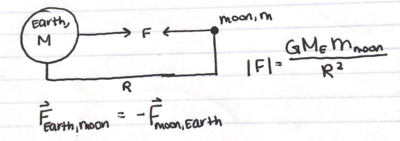
- (a) The position vector of Moon relative to Earth is,
- [math]\displaystyle{ \vec{\mathbf{r}} }[/math] = [math]\displaystyle{ \lt 2.8 x 10^8,0,-2.8 x 10^8\gt - \lt 0,0,0\gt }[/math]
- [math]\displaystyle{ \vec{\mathbf{r}} }[/math] = [math]\displaystyle{ \lt 2.8 x 10^8,0,-2.8 x 10^8\gt }[/math] m
- (b) The magnitude of position vector of Moon relative to Earth is,
- [math]\displaystyle{ |\vec{\mathbf{r}}| }[/math] = [math]\displaystyle{ \sqrt{(2.8 x 10^8)^2+0^2+(-2.8 x 10^8)^2} }[/math]
- [math]\displaystyle{ |\vec{\mathbf{r}}| }[/math] = [math]\displaystyle{ 4.0 x 10^8 }[/math] m
- (c) The unit vector of Moon relative to Earth is,
- [math]\displaystyle{ \mathbf{\hat{r}} = \frac {\vec{\mathbf{r}}}{|\vec{\mathbf{r}}|} }[/math]
- [math]\displaystyle{ \mathbf{\hat{r}} = \frac{\lt 2.8 x 10^8,0,-2.8 x 10^8\gt }{4.0 x 10^8} }[/math]
- [math]\displaystyle{ \mathbf{\hat{r}} = \lt 0.7,0,-0.7\gt }[/math]
- (d) The expression for the gravitational force on the Moon by the Earth is,
- [math]\displaystyle{ |\vec{\mathbf{F}}_{g}| = G \frac{m_E m_M}{|\vec{\mathbf{r^2}}|} }[/math]
- [math]\displaystyle{ |\vec{\mathbf{F}}_{g}| = 6.7x10^{-11} \frac{6 x 10^ {24} * 7 x 10^ {22}}{(4.0 x 10^8)^2 } }[/math]
- [math]\displaystyle{ |\vec{\mathbf{F}}_{g}| = 1.76x10^{20}N }[/math]
- [math]\displaystyle{ \vec{\mathbf{F}}_{g} }[/math] = [math]\displaystyle{ -|\mathbf{F_{grav}}|*{\mathbf{\hat{r}}} }[/math]
- [math]\displaystyle{ \vec{\mathbf{F}}_{g} }[/math] = [math]\displaystyle{ -1.76x10^{20}*\lt 0.7,0,-0.7\gt N }[/math]
- [math]\displaystyle{ \vec{\mathbf{F}}_{g} }[/math] = [math]\displaystyle{ \lt -1.232x10^{20},0,1.232x10^{20}\gt N }[/math]
Difficult
In the following problems you will be asked to calculate the net gravitational force acting on the Moon.To do so, please use the following variables:
- Mass
- mS - Mass of the Sun
- mE - Mass of the Earth
- mM - Mass of the Moon
- Initial Positions
- [math]\displaystyle{ \vec{\mathbf{r_{S}}} = \lt 0,0,0\gt m }[/math]- Position of the Sun
- [math]\displaystyle{ \vec{\mathbf{r_{E}}} }[/math] = <[math]\displaystyle{ L,0,0\gt }[/math] m- Position of the Earth
- [math]\displaystyle{ \vec{\mathbf{r_{M}}} }[/math] = <[math]\displaystyle{ L,h,0\gt }[/math] m - Position of the Moon
(a) Calculate the gravitational force on the Moon due to the Earth (b) Calculate the gravitational force on the Moon due to the Sun (c) Calculate the net gravitational force on the Moon
(a) The gravitational force on the Moon due to the Earth is,
- [math]\displaystyle{ \vec{\mathbf{r}} = \vec{\mathbf{r_M}}-\vec{\mathbf{r_E}} }[/math]
- [math]\displaystyle{ \vec{\mathbf{r}} }[/math] = <[math]\displaystyle{ L,h,0\gt }[/math]-<[math]\displaystyle{ L,0,0\gt }[/math]
- [math]\displaystyle{ \vec{\mathbf{r}} }[/math] = <[math]\displaystyle{ 0,h,0\gt }[/math]
- [math]\displaystyle{ |\vec{\mathbf{r}}| = \sqrt{(0^2+h^2+0^2)} }[/math]
- [math]\displaystyle{ |\vec{\mathbf{r}}| = h }[/math]
- [math]\displaystyle{ \mathbf{\hat{r}} = \frac {\vec{\mathbf{r}}}{|\vec{\mathbf{r}}|} }[/math]
- [math]\displaystyle{ \mathbf{\hat{r}} = \frac{\lt 0,h,0\gt }{h} }[/math]
- [math]\displaystyle{ \mathbf{\hat{r}} = \lt 0,1,0\gt }[/math]
- [math]\displaystyle{ |\vec{\mathbf{F}}_{g_1}| = G \frac{m_E m_M}{|\vec{\mathbf{r^2}|}} }[/math]
- [math]\displaystyle{ |\vec{\mathbf{F}}_{g_1}| = G \frac{m_E m_M}{h^2} }[/math]
- [math]\displaystyle{ \vec{\mathbf{F}}_{g_1} = -|\vec{\mathbf{F}}_{g_1}|*{\mathbf{\hat{r}}} }[/math]
- [math]\displaystyle{ \vec{\mathbf{F}}_{g_1} = \lt 0,-G \frac{m_E m_M}{h^2},0\gt N }[/math]
(b) The gravitational force on the Moon due to the Sun is,
- [math]\displaystyle{ \vec{\mathbf{r}} = \vec{\mathbf{r_M}}-\vec{\mathbf{r_S}} }[/math]
- [math]\displaystyle{ \vec{\mathbf{r}} }[/math] = <[math]\displaystyle{ L,h,0\gt -\lt 0,0,0\gt }[/math]
- [math]\displaystyle{ \vec{\mathbf{r}} }[/math] = <[math]\displaystyle{ L,h,0\gt m }[/math]
- [math]\displaystyle{ |\vec{\mathbf{r}}| = \sqrt{(L^2+h^2+0^2)} }[/math]
- [math]\displaystyle{ |\vec{\mathbf{r}}| = \sqrt{(L^2+h^2)} }[/math]
- [math]\displaystyle{ \mathbf{\hat{r}} = \frac {\vec{\mathbf{r}}}{|\vec{\mathbf{r}}|} }[/math]
- [math]\displaystyle{ \mathbf{\hat{r}} = \frac {\lt (L,h,0)\gt }{\sqrt{(L^2+h^2)}} }[/math]
- [math]\displaystyle{ |\vec{\mathbf{F}}_{g_2}| = G \frac{m_S m_M}{|\vec{\mathbf{r^2}|}} }[/math]
- [math]\displaystyle{ |\vec{\mathbf{F}}_{g_2}| = G \frac{m_S m_M}{L^2+h^2} }[/math]
- [math]\displaystyle{ \vec{\mathbf{F}}_{g_2} = -|\vec{\mathbf{F}}_{g_2}|*{\mathbf{\hat{r}}} }[/math]
- [math]\displaystyle{ \vec{\mathbf{F}}_{g_2} = \lt -G \frac{m_S m_M L}{(L^2+h^2)^{3/2}},-G \frac{m_S m_M h}{(L^2+h^2)^{3/2}},0\gt N }[/math]
(c) The net gravitational force on the Moon is,
- [math]\displaystyle{ \vec{\mathbf{F}}_{net} = \vec{\mathbf{F}}_{g_1}+\vec{\mathbf{F}}_{g_2} }[/math]
- [math]\displaystyle{ \vec{\mathbf{F}}_{net} = \lt 0,-G \frac{m_E m_M}{h^2},0\gt +\lt -G \frac{m_S m_M L}{(L^2+h^2)^{3/2}},-G \frac{m_S m_M h}{(L^2+h^2)^{3/2}},0\gt }[/math]
- [math]\displaystyle{ \vec{\mathbf{F}}_{net} = \lt -G \frac{m_S m_M L}{(L^2+h^2)^{3/2}},-G \frac{m_E m_M}{h^2}-G \frac{m_S m_M h}{(L^2+h^2)^{3/2}},0\gt N }[/math]
Connectedness
- Nothing interests and intrigues me as much as outer space, and the first step to understanding that is to understand the Law of Universal Gravitation. The only reason we are alive today, and part of the solar system we are in is because of the force of gravity. It controls the tides of the oceans, the orbit of Earth, and the distance of planets to the Sun (which are vital for the survival of life). It is one of the most basic concepts you learn in physics, but one of the most important of the natural forces that work to keep our universe in balance.
- As a Mechanical Engineering major, gravitational force could be important if I ever work in the aerospace field, where you must determine how much lift an airplane or spaceship needs to get off the ground in order to counteract the force of gravity. Also, if I ever assist in the designing of buildings, it is important to know all of the forces that act on them, including gravity.
- Newton's Law of Universal Gravitation acts on every single object that you see around you every day. Without it, football games would be no fun because the ball would never come back to the ground, and also because all the players and spectators would be floating off into space. If a planet or object in space has a different orbit than expected, then it can be used to find new bodies that cause that change in orbit. If we did not know the force of gravity, we would not know how fast rockets need to travel to exit the atmosphere, and how high satellites must float in order to stay in the orbit the Earth. The Apollo 13 crew would never have been able to make it back to their families had Houston not known the exact gravitational forces that the moon could exert on the spacecraft.
History
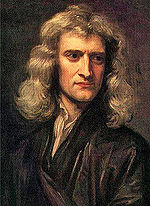
Sir Isaac Newton, the 17th century English scientist is considered one of the most important minds of the Scientific Revolution. He is popularly associated with discovering the force of gravity but scientists had been studying gravity for centuries before Newton. Based on Galileo’s and Kepler’s works on heliocentric solar system, Newton published “Principia” in 1687, in which he explained that the force that causes the planets to orbit the Sun is the same force that makes objects fall to and remain on the surface of the Earth. Newton explained that gravity is a force that attracts different masses and is inversely proportional to the square distance between the objects. However Newton did not fully understand how gravitational force acted from one object to another over vast distances due to the limited tools at his disposal. Despite this flaw, the law he developed has been used for more than three centuries and is still used mostly without issue to approximate the motion of bodies acting under gravitational force. Albert Einstein rejected it in his explanation of the Theory of Relativity, saying that the gravitational force is a result of the curvature of space-time. This theory explains a number of phenomena we observe around extremely massive bodies, including the curving of light around such bodies.
While Newton's theory of gravity falls apart under scrutiny near extremely massive bodies, and cannot explain some of the phenomena we see around these bodies, it is a good enough approximation for most situations that are encountered.
See also
- For an interesting lab on the Law of Universal Gravitation visit here
- For more information and applications pertaining to the gravitational force visit here
- This video here is much like the experiment done in lecture, and attempts to show how gravity acts on small objects by using a conical shape Watch.
- Here is a short video that reinforces the concepts laid out above.
Further reading
Matter and Interactions By Ruth W. Chabay, Bruce A. Sherwood - Chapter 3
External links
- 1: http://www.physicsclassroom.com/Class/circles/u6l3c.cfm
- 2: https://www.youtube.com/watch?v=0hOuNtRMSAI
- 3: http://csep10.phys.utk.edu/astr161/lect/history/newtongrav.html
- 4: http://www.animations.physics.unsw.edu.au/jw/gravity.htm
- 5: http://sandyabouttechnology.blogspot.com/2012/09/gravitation-force-and-application.html
References
- 1: "Newton's Law of Universal Gravitation." Newton's Law of Universal Gravitation. N.p., n.d. Web. 27 Nov. 2015.<http://www.physicsclassroom.com/Class/circles/u6l3c.cfm>
- 2: Rankin, Alan. "What Is a Gravitational Force?" WiseGeek. Conjecture, n.d. Web. 28 Nov. 2015. <http://www.wisegeek.com/what-is-a-gravitational-force.htm>
- 3: "History of Gravity." History of Gravity. N.p., n.d. Web. 28 Nov. 2015. <https://www.physics.wisc.edu/museum/Exhibits-1/Mechanics/GravPit/index_HistGrav-2.html>